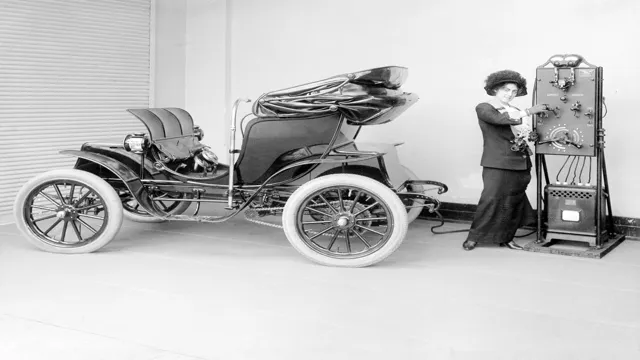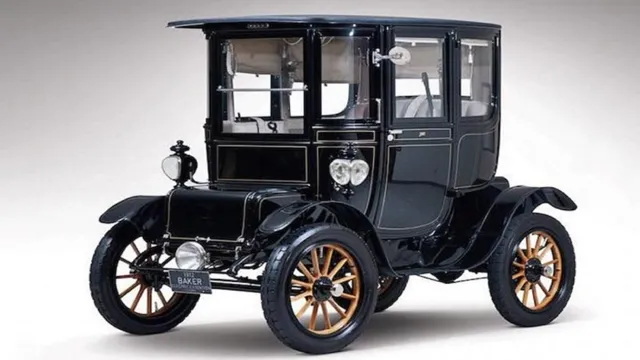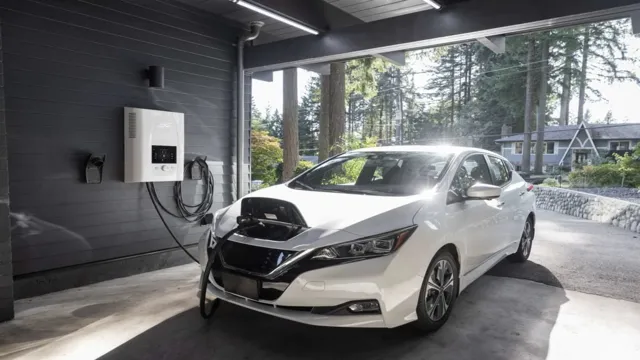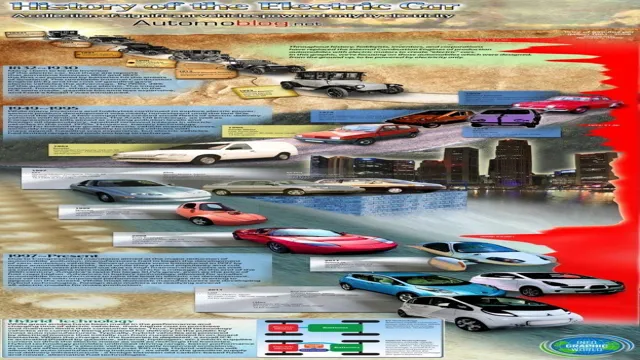Revolutionizing Mobility: A Timeline of the Electric Car’s Evolution
Electric vehicles, or EVs, have been around for many years, but it wasn’t until recently that they gained widespread popularity. In the early days of electric cars, they were often seen as impractical and expensive, with limited range and long charging times. However, in recent years, advances in technology, decreasing battery costs, and an increasing focus on sustainability have all contributed to a rapid growth in the electric car industry – which shows no signs of slowing down.
This piece explores the electric car timeline and why it’s such a hot topic in the automotive industry. From the first electric car ever created to present day, we’ll discuss the evolution of electric vehicles and how they’ve changed the way we think about transportation. So, fasten your seat belts as we take a journey through the past and present of electric cars.
Early Days: 1832-1899
The history of the electric car timeline dates back to the early 1830s when Robert Anderson invented the first crude electric carriage in Scotland. However, it wasn’t until the late 1800s that electric cars began to gain popularity with the introduction of rechargeable batteries. The first commercially available electric car was built by Thomas Parker in 1884, with subsequent developments leading to the creation of more efficient electric vehicles.
However, with the advent of gasoline-powered cars, electric cars saw a decline in sales and production in the early 20th century. Despite this setback, electric vehicles remained a viable option for urban transportation. The early days of electric cars helped pave the way for advancements in battery technology, making modern electric vehicles possible.
Today, electric cars are becoming increasingly popular as people seek environmentally friendly transportation options, and the history of the electric car timeline continues to evolve.
First electric vehicle invented
The early days of electric vehicles can be traced back to the mid-1800s. It was Scottish inventor Robert Anderson who first created the world’s first electric vehicle in 183 Anderson’s invention was powered by a non-rechargeable battery, meaning that it couldn’t be recharged and had to be replaced once it died.
However, this invention was a significant breakthrough in the world of transportation, and it paved the way for further developments in electric vehicle technology. Over the next several decades, inventors around the world started working on improving electric vehicles by creating better batteries and refining their designs. By the end of the 1800s, electric vehicles had become a popular form of transportation, especially in urban areas.
While the technology has come a long way since the early days of electric vehicles, Anderson’s invention remains a crucial milestone in the history of electric vehicles.
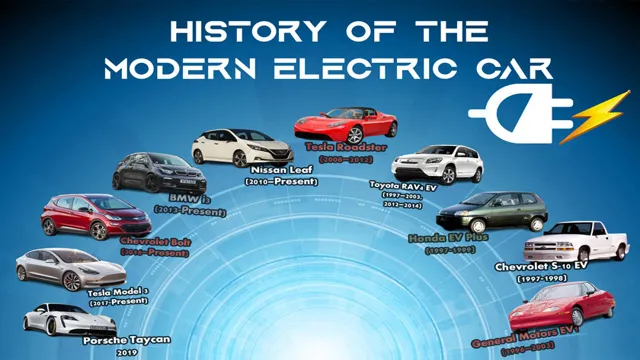
Electric taxis debut in London
Electric taxis have finally made their debut in London, marking a significant change in the city’s transportation system. The move towards electrification is a major step in curbing environmental pollution, especially in busy urban areas. Electric taxis offer numerous benefits, including reduced emissions, quieter rides, and lower maintenance costs.
This isn’t the first time London has experimented with electric taxis, though. In fact, the idea of electric-powered taxis dates back to the late 1800s, when Walter C. Bersey introduced a fleet of battery-powered cabs called the “Bersey Taxi”.
These early attempts never really took off, but it’s impressive to see how far we’ve come. As car manufacturers continue to introduce more efficient and affordable electric vehicles, we can expect to see electric taxis become the norm in the not-too-distant future, making our cities cleaner, greener, and more sustainable.
Rise and Fall: 1900-1980
The history of the electric car is a fascinating one, marked by periods of innovation and excitement as well as times of dimmed interest and fading enthusiasm. From 1900 to 1980, the electric car experienced both heights and depths. At the beginning of the 20th century, electric cars took center stage as a popular alternative mode of transportation, particularly within urban areas, where its quiet and smooth operation was preferred over the gasoline-powered vehicles of the day.
With the development of lead-acid batteries in the 1920s, electric cars continued to grow in popularity, with a peak in the 1940s and 1950s when many American households owned an electric car for neighborhood errands and daily commutes. However, a combination of factors led to the decline of the electric car in the 1960s and 1970s, including increased suburbanization and the rise of highways, which made gasoline-powered vehicles more efficient and convenient for longer trips. By the 1980s, electric cars had largely disappeared from the market, leading to a long period of dormancy until a new wave of interest emerged in the 1990s.
Electric vehicles gain popularity
Electric vehicles have been around for over a century, but their popularity has fluctuated significantly. In the early 1900s, electric cars were common on the streets of major cities, accounting for nearly one-third of all vehicles. However, as gasoline-powered cars became more affordable and accessible, electric cars fell out of favor.
By the 1980s, only a handful of electric cars were on the market, primarily for specialized uses like golf carts. But with the growing concern over climate change and the need for sustainable transportation options, electric vehicles are regaining popularity. People are becoming more aware of the benefits of electric vehicles, including reduced emissions, lower fuel costs, and smoother rides.
The rise of electric vehicles can also be attributed to advancements in technology, making these vehicles more efficient and affordable for everyday consumers. As more and more people switch to electric cars, the demand for charging infrastructure is also increasing. It’s an exciting time for the electric vehicle industry, and it looks like the trend towards more sustainable transportation options is here to stay.
Government support for electric cars disappears
The early 1900s saw a surge in the popularity of electric cars, with government officials offering various incentives to encourage their use. However, by the 1980s, this support had all but disappeared. The reasons for this change are complex.
One factor was the declining oil prices, which made gas-powered cars more affordable. Additionally, advancements in technology allowed for the creation of more efficient gas-powered cars, further solidifying their dominance. Moreover, the lack of infrastructure supporting electric cars made it difficult for them to compete with their gas-powered counterparts.
As a result, government officials shifted their focus and started investing in other forms of transportation. Despite this, electric cars have seen a recent resurgence in popularity as concerns over climate change and the environment have come to the forefront. Governments are now once again offering incentives to encourage the use of these vehicles, and it seems likely that we will see a continued push toward electric cars in the coming years.
Electric cars become niche market
From their invention in the late 1800s to the 1980s, electric cars were a common sight on the roads of major cities in the US and Europe. They were preferred by urban dwellers for their quiet operation and ease of use. However, as gasoline-powered cars became more affordable, electric cars gradually lost their popularity.
Today, electric cars are considered more of a niche market, catering to environmentally conscious drivers or those looking for a unique driving experience. Despite advancements in battery technology and the proliferation of charging stations, electric cars still face several challenges, including limited range, longer charging time, and a higher purchase price compared to traditional gasoline-powered cars. It’s fascinating to think electric cars were once a common sight on city streets.
Can you imagine a world where we could drive without the noise and pollution of gasoline engines? However, as gasoline cars became more affordable and accessible to the masses, electric cars slowly lost their appeal. Today, electric cars are seen as a niche market for those who prioritize sustainability and a unique driving experience. Though battery technology has improved, electric cars still face many hurdles, such as limited range and longer charging times, compared to traditional combustion engines.
Despite these challenges, many believe that the future of the automotive industry will be electric.
Revival: 1990-Present
The modern era of electric cars started in the 1990s, with the emergence of the General Motors EV1 and Toyota RAV4 EV. While limited in range and availability, these early electric cars sparked a new wave of interest in alternative energy vehicles. In the 2000s, Tesla Motors began producing its Roadster, followed by the Model S, which helped shift the perception of electric cars from being sluggish and unexciting to being fast and luxurious.
Additionally, government incentives and regulations played a role in encouraging the growth of electric cars, with California and other states setting emissions targets for automakers. Today, electric cars are becoming increasingly more affordable and practical, with many major car manufacturers investing in new electric models. With a push for sustainability and a shift towards renewable energy, the future of electric cars looks bright.
California mandates zero-emission vehicles
In a major effort to reduce air pollution and improve the environment, the state of California passed a mandate that all new passenger vehicles sold within its borders will need to be zero-emission vehicles by 203 This decision is a major stride towards reducing greenhouse gas emissions and aiding the efforts to combat climate change. The government is taking proactive steps to encourage Californians to drive electric vehicles by setting goals that hold carmakers accountable for upping their production of zero-emission vehicles significantly.
The best part of this mandate is that it will not only reduce greenhouse gas emissions, but it will also help save drivers money since EVs have lower long-term maintenance costs and energy expenses compared to traditional cars. This mandate will improve the quality of life for Californians and sets an example for other states to follow if they wish to limit greenhouse gas emissions and reduce air pollution.
Tesla Motors introduces first electric sports car
Tesla Motors started a revolution in the automotive industry with the introduction of their first electric sports car. From 1990 or so till today, we can see how much a single innovation can make a change. The Tesla Roadster debuted in 2008 and was a game-changer in the electric vehicle market.
Its design, performance, and range were all top-notch, and it proved that electric cars could be just as good – if not better – than their gasoline counterparts. This was a significant step forward in the revival of electric cars, which had been struggling to gain mainstream acceptance due to the limitations of their battery technology. Tesla’s innovation led the way for other carmakers to follow suit and invest in electric cars, paving the way for a cleaner and more sustainable future.
Tesla continues to lead the industry with their electric-powered vehicles, and the Roadster remains a symbol of what’s possible when ingenuity meets sustainability.
The Future of Electric Cars
The history of the electric car timeline spans back to the 1800s, when early experiments with electric engines began. However, it wasn’t until the 1990s that electric cars started becoming more popular again. Since then, manufacturers have been slowly improving the technology, with newer cars offering faster charging times and longer driving ranges.
With the push for more eco-friendly vehicles, it’s no surprise that electric cars are becoming more mainstream. The future of electric cars looks bright, with advancements in battery technology and the development of self-driving cars. Experts predict that by 2030, electric cars will make up at least 30% of the global car market.
It’s an exciting time for the automotive industry, and we can’t wait to see what comes next.
Conclusion
As we look back on the history of the electric car, it’s clear that it has been a bumpy ride. From early experiments in the 1800s to the modern-day push for widespread adoption, the electric car has faced challenges at every turn. But despite the setbacks, it’s clear that the electric car is here to stay.
With advancements in battery technology, charging infrastructure, and public demand, the electric car has never been more viable. So let’s raise a glass to the electric car, and buckle up for a bright future on the road ahead!”
FAQs
When was the first electric car invented?
The first electric car was invented in 1837 by Scottish chemist Robert Anderson.
How did the invention of the rechargeable battery impact the development of electric cars?
The invention of the rechargeable battery in the 1850s allowed for longer driving ranges in electric cars, leading to more widespread use.
What contributed to the decline in popularity of electric cars in the early 20th century?
The discovery of large reserves of petroleum and the ability to produce gasoline-powered cars at a lower cost led to the decline in popularity of electric cars.
When did electric cars begin to see a resurgence in popularity?
Electric cars began to see a resurgence in popularity in the 1990s, with the introduction of the General Motors EV1 and other electric cars from automakers like Toyota and Honda.
